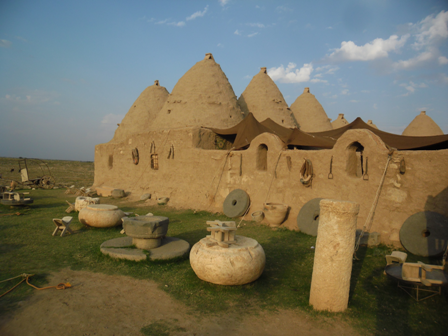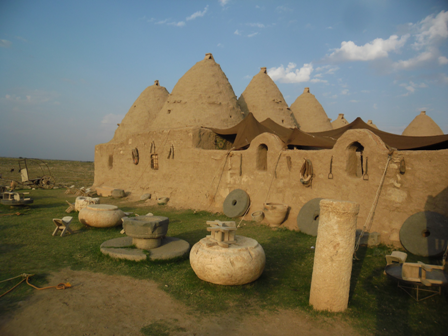
Join our Irish roving reporter Caroline on her travels around Turkey.
Sanliurfa – South-eastern Anatolia’s ancient gem.
I recently had the great pleasure of visiting Sanliurfa, city of Prophets. Reaching back to the dawn of time, this ancient city was, according to the Bible and the Quran, the birthplace of the Prophet Abraham, founder of the three great Monotheistic religions, Judaism, Christianity and Islam.
On a cloudy, blustery late October day, I arrived at Sanliurfa’s GAP airport and took the Havas shuttle into the city centre. There is a huge amount of construction going on around the city, and the wind blew clouds of dust everywhere. A short taxi ride to the centre of the old city brought me to my hotel, the Istiklal, which is conveniently located 2 minutes from all the major attractions! I was out and about in no time, covering myself with a loose fitting tunic over my jeans, and a headscarf in my bag out of deference to the conservative local population.
My first stop was the Balikligol, a huge park featuring a beautiful lake filled with sacred carp, in front of a complex of Mosques and surrounded by arched arcades packed with people out for a stroll or to pay their respects at the Cave of Ibrahim (Abraham). Every woman, young or old wore a headscarf, and some of the more elderly ladies sported indigo tatoos on their forheads, cheeks and chins. I became aware of an almost overwhelming Arabic presence and influence, evidenced by local dress. Many women were completely covered by black or brown ‘ihrams’ (female coat), with only their eyes visible, while the men’s attire ranged from the baggy farmers pants to the Arab ‘dish-dashas’ (long tunic). Many different types of head coverings were in evidence from ‘keffiyas’ in chequered black and white commonly worn by Kurdish men or red and white by Arabs. Another head scarf on show was the ‘posu’, worn by local men and frequently in shades of lavender and lilac, which I found quite charming! Many people were speaking Arabic.
Ok enough about fashion, back to the history and mythology of the Balikligol. Muslim tradition believes that the evil King Nimrud had a dream which foretold a threat to his rule, so he decreed that henceforth all newborn male children should be killed. When Abraham was born, he was brought up in hiding in the cave at Balikligol until he was 7 years old. In later years he challenged the Pagan practice of idolatry and incurred the wrath of King Nimrud, who was a nasty piece of work. The King catapulted Abraham onto a funeral pyre, but God intervened and turned the fire into water and the burning wood into carp, and Balikligol came into being.
At the Cave of the Prophet Abraham, there are separate entrances for women and men, and being a pilgrimage site, especially for Muslims, conservative dress is strictly applied and full body and head coverings are required. The womens’ side was crammed with worshippers so I could only take a brief peek inside the cave. It was dark but I could see many women filling containers and bottles with sacred, healing water from a spring at the back. I strolled back to the lake to take photos and a friendly young lad gave me the remains of a bag of fish food. The carp jumped out of the water – and I nearly jumped out of my skin – at their voracious appetites when I poured the food onto the lake! What a heaven for these great fish! But another local tradition states that if anyone tries to catch one, especially a rare white carp, he/she will go blind!
It started to rain, so I took shelter in a tea house and ordered my first ‘menengec kahvesi’ – it’s delicious nutty flavour was a welcome change from Nescafe instant and I got to like this local coffee in a big way! A local guide, Yilmaz, joined me for a tea and told me all about the many delights of Sanliurfa. When he mentioned that he had a car, I was sold and we were literally off to the races!
With Yilmaz at the wheel, I quickly discovered the manic traffic of Sanliurfa. As we raced through the rainy narrow streets of the old city, he sped around corners and negotiated seemingly blocked entrances with ease, occasionally exclaiming ‘Manyak’ (maniac) at some poor motorist who drove the opposite direction with centimetres to spare. Yilmaz frequently screeched to a halt to greet some family member, high official in the Belediye (local county council) or friend! On one of our forays around the city we actually met Klaus Schmidt, the chief archaeologist who has been excavating the incredibly ancient site of Gobekli Tepe since 1994. More on this later…
We emerged from old Sanliurfa and entered the smart new city to have dinner. Parking anywhere here is a nightmare, with eagle eyed ‘parking cops’ lying in wait to snare their prey, but with Yilmaz there was never a problem! Everybody knew him and cafes, fast food joints and restaurant staff happily moved their own cars so he could park right outside where we ate. Even the police let him away with minor transgressions. There is massive and rapid development happening all over the city, with the Government pouring money into this whole region, evidenced by the chic and expensive clothing stores and shopping centres. It is also, like most cities throughout Turkey, incredibly family friendly, with many tea gardens, parks and playgrounds, and most cafes and restaurants have family or women only areas.
The food in Sanliurfa is great, but unexpectedly spicy due to the particularly hot peppers grown in this region. Our first meal that evening was at his cousin’s fast food cafe right on the main street. We had tasty beef shish kebaps wrapped in local flat bread and salad, but my first bite had my throat burning and eyes watering. I was soon introduced to the local remedy, yoghurt ‘corba’, a cold, delicious soup containing different types of beans or grains, ideal for combatting the fiery spices! Other local delicacies from this region are the famous ‘Urfa’ kebap, Cig Kofte (raw lamb kofte), Patlican (aubergine) kebab and offal prepared and cooked in various spicy ways.
Read more on carolines adventures next month.











